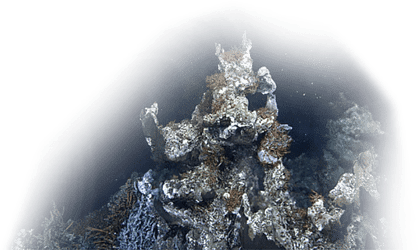Saanich Inlet is one of the best-studied marine basins in the world. The combination of easy access and unusual features has attracted researchers to this glacially carved fjord since the 1930’s. A unique feature is the combination of geography, dense plankton populations, and deep water that is a natural “dead zone”—an area depleted in oxygen. Once a year, in the late summer or early fall, oxygen is restored. The result is a fascinating study area for biologists, chemists, and sedimentologists.
ONC installations in Saanich Inlet, British Columbia.
In June 2014, Ocean Networks Canada (ONC) installed a cabled water column profiling system in Saanich Inlet. The inshore profiling system consists of a surface buoy equipped with a meteorological station and a winch used to raise and lower an underwater instrument package through the water column. Instruments on the profiler measure water column properties such as temperature, salinity, dissolved oxygen, and phytoplankton biomass. The real-time data from the Saanich inshore profiling system at Yarrow Point can be viewed via ONC’s data management system Oceans 2.0.
The buoy-based vertical profiling system being towed into dock for final testing in Patricia Bay, August 2013.
This year, University of Victoria postdoctoral researcher Jeff Sorensen is leading a project to study how the chemistry of the Saanich inlet changes over the course of a year.
Saanich Inlet project sheds light on ocean dead zones
University of Victoria Media Release, 22 November 2016
Oceanographers from around the world are learning more about the science of “dead zones,” thanks to a University of Victoria-led research project currently taking place in Saanich Inlet near Victoria.
Every two weeks since September, a research team has been venturing into the inlet on the University of Victoria research vessel MSV John Strickland to collect water samples—roughly 300 litres per day— at multiple depths to measure water chemistry from dissolved gases and trace metals to phytoplankton and microbes. Saanich Inlet is a deep glacial fjord separated from adjacent waters by a shallow sill that restricts water inflow. It’s widely known as a natural laboratory for studies of “anoxic” or dead zones, areas in the ocean that are devoid of oxygen and marine life. The only lifeforms that can exist there are bacteria.
“The inlet is a natural dead zone, meaning it has low to no oxygen content for most of the year,” says Sorensen. “We’re seeing dead zones increasing around the world, and that changes what species are able to live there, including a lot of fish and shellfish that people depend on to eat.”
University of Victoria Undergraduate student Erinn Raftery and researcher Jeff Sorensen adjust the equipment used to collect water samples in Saanich Inlet. Credit: University of Victoria.
While Saanich Inlet remains anoxic for much of the year, every fall water flows in over the sill and replenishes the oxygen supply. Marine life flourishes for the next few months, but wanes again as the water’s oxygen content gets used up.
“We know there’s a cascade of chemical reactions that happen as the oxygen is used up,” says Sorensen. “We want to see how these reactions evolve over time and how they interact with each other.”
Although the Inlet’s anoxic conditions have been well-studied in the summer months, little work has been done in the winter. This project, which runs until next May, marks the first time that a wide range of measurements are being taken over the duration of the oxygen depletion process.
ONC intern Caitlin Frenkl has been helping to collect physical data for the project and comparing it to the data collected by the Saanich Inlet buoy profiling system.
About 30 researchers from the University of Victoria are involved, as well as scientists from ONC and Fisheries and Oceans Canada in Sidney. ONC is also providing real-time data in between research cruises from a nearby instrument connected to its first internet-connected subsea observatory that has been collecting data in the inlet since 2006. The water samples are being collected close to that instrument.
International scientific interest in the project is broad, with 20 research groups from Switzerland, Ireland, England, Spain, Brazil, the U.S. and elsewhere in Canada signed on to for water samples. “These are all world experts in their field who don’t have easy access to a natural dead zone like this,” says Sorensen.
The project is funded by the Natural Sciences and Engineering Research Council.
